

CFS - The Central Cause: Mitochondrial Failure. Published papers 16th January 2009 saw the publication of "Chronic Fatigue Syndrome and Mitochondrial Dysfunction", our paper (authors: Prof Norman Booth of Oxford University, Dr John McLaren-Howard of Acumen Laboratory and myself) presenting evidence that chronic fatigue syndrome has a physical basis.
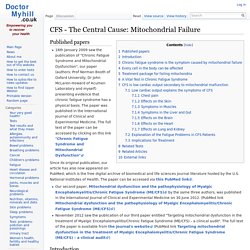
The paper was published in the International Journal of Clinical and Experimental Medicine. The full text of the paper can be accessed by clicking on this link "Chronic Fatigue Syndrome and Mitochondrial Dysfunction" Since its original publication, our article has also now appeared on PubMed, which is the free digital archive of biomedical and life sciences journal literature hosted by the U.S.
National Institutes of Health. Glutathione Depletion-Methylation Cycle Block: A Hypothesis For the Pathogenesis of Chronic Fatigue Syndrome by Richard A. Van Konynenburg Ph.D. Independent Researcher and Consultant, (richvank@aol.com) Rich proposed that methylation induced glutathione depletion is responsible for many symptoms in chronic fatigue syndrome At the Seventh International Conference of the AACFS in 2004, the author proposed and defended the hypothesis that glutathione depletion is an important part of the pathogenesis of CFS (1).

In the conclusions of that paper it was noted that it seemed likely that there are vicious circle mechanisms involved in CFS that prevent glutathione repletion from being the complete answer for treating this disorder. Recent autism research (2,3) suggests that in that disorder a vicious circle involving the methylation cycle apparently chronically holds down the level of glutathione.
Chronic Fatigue Syndrome Neuroinflammation: Peeling the Onion - Wellness Resources. Gut inflammation in chronic fatigue syndrome. Chronic fatigue syndrome (CFS) is a clinical condition characterized by persistent and unexplained relapsing fatigue that is worsened by physical and mental exertion [1, 2].
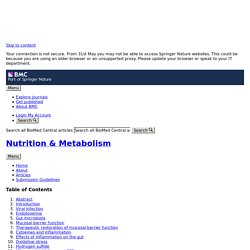
According to the Centers for Disease Control (CDC) report, the overall prevalence of CFS in the USA is as many as 4 million people [3, 4]. Up to 80% of those affected are women [5]. These individuals suffer from severe fatigue that impairs daily activity, diminishes quality of life (QOL) for years, and has no known cure. CFS represents an economic burden for society and healthcare institutions [6]. The CDC originally proposed the term CFS in 1988. Along with disabling fatigue, CFS is characterized by neuropsychological disturbances such as headaches, myalgia, arthralgia, and post-exertional malaise; cognitive difficulties, with impaired memory and concentration; un-refreshing sleep; and mood changes, such as depression and anxiety [8].
A Mystery No Longer? The Big Picture Emerging In Chronic Fatigue Syndrome? Dr. Bateman Talks.
CFS/ME and the Mitochondria. Immune System Dysregulation and Irregularities. Dysregulation of Nitric Oxide. Postural Orthostatic Tachycardia Syndrome (POTS) Neuroendocrine Dysfunctions in Prolonged Critical Illness: Relevance for Chronic Fatigue Syndrome ME/CFS and Fibromyalgia Pt. I. Prolonged or chronic critical illness – a term applied to patients that survive severe injury or infection, but fail to start recovering after a few days – is characterized by low levels of peripheral hormones (including T3, IGF-1, cortisol and testosterone).
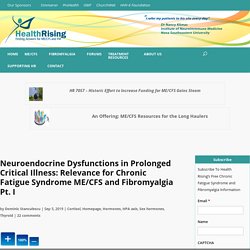
This pattern is increasingly recognized as a neuroendocrine dysfunction inhibiting patients’ recovery, requiring treatment independent of the initial illness or trauma.
Changes In The Brain and Neuroinflammation. Dysfunctional Autonomic Nervous System. HPA Dysregulation. Metabolic Changes. Low Heart Function. Post Exertional Malaise (PEM) and Fatigue. Exercise Intolerance. Histamine and Chronic Fatigue Syndrome/ME and Fibromyalgia. EMF Sensitivity and CFS/ME. Circulatory Problems. Food Sensitivities and CFS/ME. Deficiencies in CFS/ME. Sleep Disturbances and Circadian Rhythm Disruption and CFS/ME. In Brief: Viruses and ME. In Brief: Autoimmunity and ME. The second in series of short articles attempting to explain the science behind fairly common topics and exploring how they relate to ME.
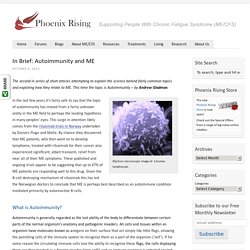
This time the topic is Autoimmunity – by Andrew Gladman. Electron microscopic image of a human lymphocyte. In the last few years it’s fairly safe to say that the topic of autoimmunity has moved from a fairly unknown entity in the ME field to perhaps the leading hypothesis in many peoples’ eyes. This surge in attention likely comes from the rituximab trials in Norway undertaken by Doctors Fluge and Mella. By chance they discovered that ME patients, who then went on to develop lymphoma, treated with rituximab for their cancer also experienced significant, albeit transient, relief from near all of their ME symptoms. In Brief: Mitochondria and ME.
The third in a series of short articles attempting to explain the science behind fairly common topics and exploring how they relate to ME.
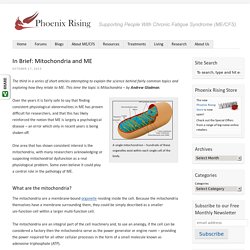
This time the topic is Mitochondria – by Andrew Gladman. A single mitochondrion – hundreds of these organelles exist within each single cell of the body. In Brief: The Cardiovascular System and ME. The fourth in a series of short articles attempting to explain the science behind fairly common topics and exploring how they relate to ME.
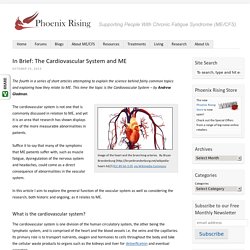
This time the topic is the Cardiovascular System – by Andrew Gladman. In Brief: The Autonomic Nervous System and ME/CFS. The fifth and final article in a series attempting to explain the science behind fairly common topics and exploring how they relate to ME/CFS.

This time the topic is the nervous system – by Andrew Gladman. The nervous system, specifically the autonomic nervous system, is frequently discussed in relation to ME/CFS, with quite a plethora of research being targeted in this area. Many of the symptoms that ME/CFS patients suffer with, such as crushing fatigue, tremor sensations and headaches, could come as a direct consequence of abnormalities in the nervous system. Chronic Fatigue Syndrome Symptoms Checklist. Oxidative stress levels are raised in chronic fatigue syndrome and are associated with clinical symptoms. - PubMed - NCBI. Dysautonomia - Modern research. “Dysautonomia” or “autonomic dysfunction” occurs when there is abnormal functioning in nerves controlling many everyday body activities.
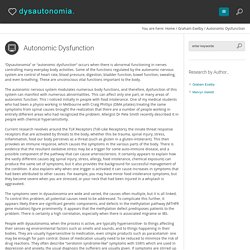
Some of the functions regulated by the autonomic nervous system are control of heart rate, blood pressure, digestion, bladder function, bowel function, sweating, and even breathing. These are unconscious vital functions important to the body. The autonomic nervous system modulates numerous body functions, and therefore, dysfunction of this system can manifest with numerous abnormalities. This can affect only one part, or many areas of autonomic function. This I noticed initially in people with food intolerance. Current research revolves around the TLR Receptors (Toll-Like Receptors), the innate threat response receptors that are activated by threats to the body, whether this be trauma, spinal injury, stress, inflammation, food our body perceives as a threat (such as gluten in a gluten-intolerant).
Myalgic Encephalomyelitis. A study by Stanford University researchers demonstrated abnormalities in the brains of illness sufferers compared to those of healthy controls.
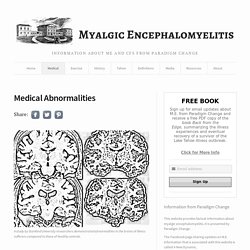
More than 500 peer-reviewed articles have been published demonstrating a wide variety of physiological abnormalities in patients with “chronic fatigue syndrome” (a broader condition that currently encompasses patients with the more specifically defined condition of myalgic encephalomyelitis). To read the citations and a brief description of each article, please click on the topic links below. Peterson's Atypical Subset Opens New View of ME/CFS in Columbia/Simmaron Publication. “We now have biological evidence that the triggers for ME/CFS may involve distinct pathways to disease, or, in some cases, predispose individuals to the later development of serious comorbidities.” Dr. Mady Hornig. The Subset Makers. A Modifiable Piece of the ME/CFS Puzzle: BDNF — Dr Courtney Craig.
Leading ME/CFS researcher Lenny Jason and his group just released a novel study showing that the protein Brain Derived Neurotrophic Factor (BDNF) was below normal levels in Chronic Fatigue Syndrome patients (1). This study provides another biomarker that validates the illness as real and organic. But, most importantly, it presents another modifiable piece of the complex puzzle of CFS. What is BDNF? BDNF is a central nervous system growth factor protein coded for by a gene of the same name. Death in Chronic Fatigue Syndrome (ME/CFS) - What has it Told Us? The Autopsy Files. Leveraging Leptin — Dr Courtney Craig. All about Eve The incidence of both fibromyalgia and ME/CFS is far more common in females, yet the reason for this is still unknown.
With the new finding of leptin in these groups, plausible explanations begin to emerge. The level of leptin is 3 times higher in women than men. This due to the fact that estrogen stimulates leptin production, while testosterone lowers it. Leptin also has been found to be higher during the premenstrual phase, especially in women with PMS (5). Modulating Leptin In his webinar, Younger stated that chronic leptin suppression through medications or other means is likely not indicated.
Myalgic encephalomyelitis/chronic fatigue syndrome and encephalomyelitis disseminata/multiple sclerosis show remarkable levels of similarity in phenomenology and neuroimmune characteristics. Heart Rate Variability - Why You Should Know Yours. The Neuroinflammatory Etiopathology of Myalgic Encephalomyelitis/Chronic Fatigue Syndrome (ME/CFS). - Wellness Resources. Simmaron's Spinal Fluid Study Finds Dramatic Differences in Chronic Fatigue Syndrome - Simmaron Research.
“Our results indicate a markedly disturbed immune signature in the CSF of ME/CFS subjects that is consistent with immune activation in the CNS.”Dr. Mady Hornig, Director of Translation Research, Columbia University Columbia University just published groundbreaking results of the first spinal fluid study to compare ME/CFS with Multiple Sclerosis and healthy controls. For almost his entire career treating CFS patients, Dr. Daniel Peterson has been working toward this day. Simmaron Research, founded by Dr. Molecular Psychiatry. 2015 Mar 31. doi: 10.1038/mp.2015.29. Cerebral spinal fluid is a colorless fluid that surrounds and cushions the brain and spine. Lumbar punctures such as those used in this study are primarily used to diagnose neurological disorders. Bones Pt II: Chronic Fatigue Syndrome (ME/CFS), Fibromyalgia, Osteoporosis and Getting Older. An Easy Way to Tell if You Have Small-Fiber Neuropathy? The Fibromyalgia Symptom Study. What Is Toxin Bioaccumulation? How Biotoxin Accumulation Causes (Reversible) Chronic Dysfunction.
General Rule Of Thumb The overall point here is to avoid all toxic biotoxins (as much as possible), but may not be possible for everyone's lifestyle. For example, viruses (e.g. herpes) can get stuck in the nervous system, and we have yet identified methods to remove it, although we do know great ways to inhibit its replication. R Just like food/water, anything can be toxic (dependent on the dose) and proper elimination/ moderate usage (e.g. not mega-dosing zinc) is probably the best bet. R Although, many toxicants (e.g. solvents, pesticides, petrochemicals, mycotoxins, synthetic chemical agents) are persistent pollutants with half-lives that can last for many years or decades. Of course, eliminating the most harmful things from your life in the short-term (some pharmaceuticals, bacterial infections, mycotoxins, highly reactive chemicals, etc) are critical for being healthy now.
In the long-term, removing every toxin (although challenging) is the best thing you can do for your health. Fibromyalgia Pain Linked with Glutamate and Histamine - Wellness Resources. The Benefits of Lactate - This is Not a Waste Product! I believe the high/clear-headedness we get from exercise is from not only endorphins, but from lactate's ability to increase vasodilation and oxygenation of the brain tissue. Fat cells can produce lactate under anaerobic circumstances, depending on the fat mass. R Lactate can then enter the brain. R Also, endurance training increases the number of lactate transporter molecules, making it easier for lactate to reach the brain and give you more energy. Exercise also creates more mitochondria via lactate.
Does Hypothyroidism Cause Chronic Fatigue? Alpha-MSH: Get Tan While Being Indoors...oh yeah and Deactivate Autoimmunity. A-MSH is an anti-inflammatory hormone. R It helps build a tolerance to our own and foreign protein (like E. Professor Kenny De Meirleir on Chronic Fatigue. Webinars by Prof Julia Newton. Six web seminars by Prof Julia Newton of Newcastle University, UK are now available to view, hosted by the active Dutch organisation ME info – formerly ME/CVS Vereniging.
These talks are produced under the auspices of ‘Science to Patients’, which is a Dutch government subsidized project, in which the gap between medical science and patients is bridged by inviting scientists to deliver short webinars on topics of concern to patients. Wenzhong Xiao, PhD, and the Big Data Study of ME/CFS.